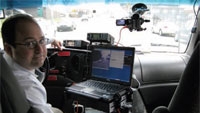Live newsgathering and streaming video
It's the age of immediacy for global newsgathering. Viewer expectations have never been higher for up-to-the-minute reporting direct from the source of breaking news, which puts additional pressure on media companies to get the story before their competition. The traditional approach to securing coverage from a remote location has been to roll a truck, with all of the expenses and complexity that go along with it. Not only is a mobile satellite vehicle expensive to maintain and operate (factoring in satellite uplinking costs), but it requires the presence of a trained technical crew. In some cases,a vehicle might be physically incapable of getting to the story location.
Fortunately, the increasing availability of low-cost wireless technologies and IP networks offers new options for remote and live newsgathering. Armed with a video camera, a simple encoding appliance or IP encoding software loaded onto a PC or smart phone, and an Internet connection, a reporter can stream live video to the newsroom in a matter of minutes.
It's all about the codec

The heart of any effective streaming video solution is the codec, which compresses video and audio from a camera into IP data packets for efficient transport over the Internet or an IP network, and then decodes the packets back into video on the other end. Therefore, the quality of the codec should be the first consideration when evaluating a hardware- or software-based encoding/decoding solution for IP streaming. At the most basic level, the codec should deliver the best quality possible and reliability at low delay while scaling over multiple data rates to ensure quality transmission and playout of both HD and SD video streams.
Look for a codec system that uses discrete cosine transform (DCT) compression while supporting metadata encapsulation. Some codecs may use the high-delay TCP/IP transmission protocol. Others may rely on the faster UDP protocol. Also, look for good bandwidth management. Unrestricted compression will rapidly consume bandwidth, so be sure the encoder provides a constrained variable bit rate (CVB) that enables the user to determine the maximum bandwidth to be consumed. Encoding software should also support a wide variety of field devices, including laptops and mobile phones.
Of course, video quality and latency are prime considerations for any IP streaming solution. One quick indication of the codec's quality standard is the shape of the pixels. Determine if the codec is optimized for broadcast-quality viewing or for viewing on a computer (in which case the pixels are more square). Also, ask how the codec handles adverse networking conditions; does it macro block or does it handle networking glitches gracefully by reducing resolution? An encoder should include forward error correction (FEC).
On the decoding side, the codec should include scaling algorithms, which can improve the image quality of low-resolution video. Another desirable decoder feature is a jitter buffer, which manages the common network occurrence in which packets arrive out of order (most typically seen over wireless networks) by queuing up and then rearranging the order of the packets.
The professional video industry's #1 source for news, trends and product and tech information. Sign up below.
Network considerations
IP streaming technology enables field reporters to take advantage of whatever network resources might be available at a given remote location. This means that even a low-data-rate IP network can enable the transmission, whether it's a hotel's Wi-Fi, a dedicated T1 or E1 line, or local area network. Now that 3G and 4G cellular networks are becoming more common in major cities around the world, a laptop equipped with a 3G/4G air card is often all that's needed to transport broadcast-quality video.
Some sophisticated encoders support mobile 3G/4G bonding, which enables users to bond two or more cellular data cards for wireless IP access. This can increase the available bandwidth up to 1.5Mb/s or more, making it possible to stream HD video in 720p or 1080i. Another popular option is a connection via a mobile satellite data terminal such as BGAN, with which a news crew can literally send video from anywhere on the planet. A minimum network speed for SD is 64kb/s; for HD it is 500kb/s.
Live versus store-and-forward streaming
Some production applications require on-site editing. This may require a store-and-forward capability. Here, the video may need to be exported to an edit platform, in 4:2:0 or 4:2:2 color for SD and HD. Be sure the encoder is capable of fast performance if you need this function.
The edited files can then be sent back to the studio at much higher bit rates than live video. However, the file size increases with the bit rate, requiring more bandwidth and sometimes slowing upload times.
Although your crews may never need to transmit live video from the top of Mount Everest as one team of climbers recently did, news staffs everywhere sometimes need to transmit from rugged and physically difficult locations. Next-generation encoding solutions for streaming video over IP networks offer highly effective solutions to this challenge.
Ben Larson is a project manager for Streambox.
